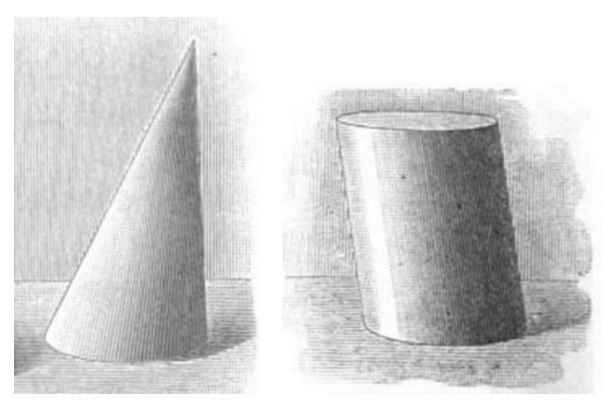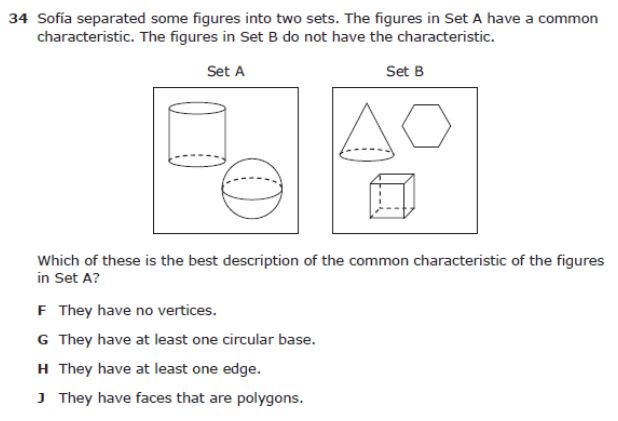Take a look at this picture of a rectangular prism:

How many vertices does it have? 8
How many edges? 12
How many faces? 6
Easy, right?
Let’s try another one. Take a look at this picture of a cone:

How many vertices does it have? Does the point at the top count?
How many edges? Hmm, I’m not sure. Aren’t edges supposed to be straight?
How many faces? That’s easy! One. There’s a circular face on the bottom. But that’s not a polygon, so is it still a face? Oh, and what do I call the other surface on the cone? Don’t faces have to be flat?
A common question we receive from teachers in grades 1, 2, and 3 has to do with how to describe the attributes of certain three-dimensional solids, specifically cylinders and cones. According to the TEKS, students are supposed to describe three-dimensional solids using formal geometric language such as vertex, edge, and face. The trouble is that we’re trying to use language that works for one class of shapes to describe the attributes of a completely different class.
Three-dimensional shapes like prisms and pyramids are polyhedrons. “In geometry a polyhedron is simply a three-dimensional solid which consists of a collection of polygons, usually joined at their edges.” (Source) These solids have “flat polygonal faces, straight edges, and share corners or vertices.” (Source)
Spheres, cylinders, and cones, on the other hand, are not polyhedrons. As a result, we can’t use the exact same language to describe them, or if we do use the same language it’s with the understanding that the definitions are not identical. Take the word vertex, for example.
On a rectangular prism, a vertex is the sharp point or corner where edges meet. A rectangular prism has 8 vertices.

However, this same term can also be used to describe the point of a cone. Same term, but not the same definition. As Dr. Math says,
The really tricky part here is that the “vertex” of a cone has nothing to do with edges, so it needs a whole new definition; and I can’t think of a really good elementary-level definition for what they obviously mean, which is simply a “point.”
As students pursue more advanced mathematics, they can develop more sophisticated language and definitions. In the meantime, while they are in elementary school, we use the term vertex of a cone in RRISD to describe this attribute of a cone.

If we want students to describe and classify this kind of three-dimensional solid, then we need to provide accessible language for that purpose.
What about the other attributes of a cone? Again, our goal is to provide language that is accessible for elementary students and descriptive of these attributes, recognizing that our students will develop more formal understandings later in their school careers. To describe a cone, we would say that it has a circular base, the flat surface upon which the cone rests. We also say that it has a curved edge along the base and a curved surface that extends from this edge up to the vertex.
What about a cylinder? Now that we have accessible language to describe attributes of a cone, we can extend this language to describe attributes of cylinders.

The above cylinder is composed of two circular bases, one on top and one on the bottom. It also has two curved edges, one along the top and one along the bottom. Finally, it has a curved surface that extends from the bottom edge up to the top edge.
I should add that both the cone and cylinder I’ve described are a right circular cone and right cylinder. As with polygons and polyhedrons, there are many other kinds of examples of these shapes. For example, the cone or cylinder might slant, making them oblique.

It is important for students to see a variety of examples of two- and three-dimensional figures. The more they encounter, the more they have to confront their definitions and terminology which serves to strengthen their understanding of the attributes and how they help us identify and classify these figures.
So what does this look like on STAAR?
On the 2016 released test, STAAR asked a question that addressed this very topic and reinforced the vocabulary we are using in RRISD.

The correct answer is F They have no vertices. If you look at Set B, you’ll notice that it includes a cone, which as we discussed earlier does have a vertex. If the Texas Education Agency were not using the term vertex of a cone, then we likely would have seen the cone included in Set A.
Here’s a parting thought from Dr. Math:
What definition you use depends on what you are going to do with it. If you are just describing objects, my loose definition is fine. If you are going to prove theorems involving planes and angles, you’ll want to restrict yourself to the polygonal definition, but then you won’t be asking any questions about cones. I think people often fail to realize that even though we are particular about definitions in math, those definitions vary from field to field, as they are adapted to a certain context. That’s what I’m trying to do here.

Thank you for sharing what you found out. I have found this to be an interesting topic to navigate and appreciate the information. Through trial and error I’ve landed on a similar way of describing the cone and cylinder but your post helps me increase my confidence in the information that I share with my students!
LikeLike